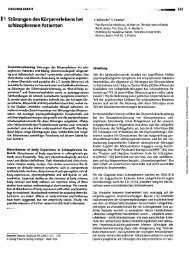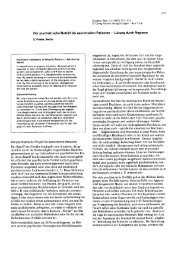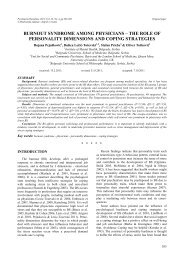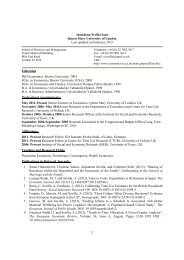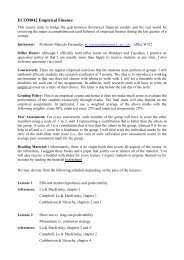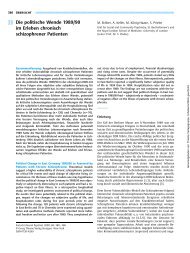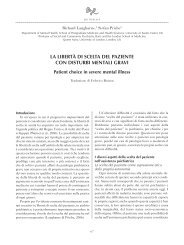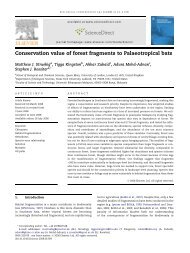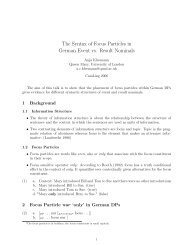Proofs - Personal Webspace for QMUL - Queen Mary, University of ...
Proofs - Personal Webspace for QMUL - Queen Mary, University of ...
Proofs - Personal Webspace for QMUL - Queen Mary, University of ...
You also want an ePaper? Increase the reach of your titles
YUMPU automatically turns print PDFs into web optimized ePapers that Google loves.
SD=15.9; t(183)= - 2.575; p=.011). Also, the negative impact <strong>of</strong><br />
unemployment was particularly high in Turkish women living<br />
at risk <strong>for</strong> poverty (M=72.1, SD=22.6); although small subsample<br />
size (N=8) did not allow <strong>for</strong> further analysis. In the German group<br />
the effect <strong>of</strong> unemployment on the level <strong>of</strong> distress was lower,<br />
but still signifi cantly higher than <strong>for</strong> all other employment<br />
groups (M=57.6, SD=12.5 vs. M=49.6, SD=11.3; t(192)=- 2.76;<br />
p=.006), but no difference was found <strong>for</strong> the poverty risk group.<br />
In the total sample no difference was found between educational<br />
groups (high level: M=50.4, SD=13.1, medium level: M=52.0,<br />
SD=13.9, low level: M=55.1, SD=17.9; F(2, 369)=2.23; p=.109).<br />
In additional analyses <strong>of</strong> interactions between SES indicators<br />
the level <strong>of</strong> education was found to be negatively associated<br />
with employment in German women (- 1.6, p=.026), but not<br />
in Turkish women (.09, p=.214). In the Turkish group poverty<br />
risk was correlated with level <strong>of</strong> education (- 1.9; p=.012), but<br />
not in the German group (- .07, p=.319). Overall, mean level <strong>of</strong><br />
emotional distress was slightly, but not signifi cantly higher<br />
Table 1<br />
Demographic characteristics <strong>of</strong> the sample.<br />
Variable Total sample<br />
(N=405)<br />
MC. Aichberger et al. / European Psychiatry 27 (2012) / supplement n°2 / S10-S16 S13<br />
in the poverty risk group (M=53.2, SD=15.1 vs. 51.1, SD=13.5;<br />
t(332)= - 1.39; p=.166). Though, the mean GHQ- 28 scores were<br />
signifi cantly higher in the Turkish group at poverty risk compared<br />
to the German group (M=55.9, SD=16.8 vs. M=50.4, SD=1.4;<br />
t(162)= - 2.32; p=.0214).<br />
Multivariate analyses were conducted to examine the<br />
combined contribution <strong>of</strong> all SES variables. Linear regression<br />
analyses were conducted <strong>for</strong> the total sample and stratifi ed<br />
by migration background. Table 2 presents results from linear<br />
regression analyses by migration background (Table 2).<br />
In the total sample unemployment (ß=8.7, 95%CI=3.6- 13.8;<br />
p=.001) and being single (ß=3.5, 95%CI=.2- 6.9; p=.036) were<br />
strongly associated with increased levels <strong>of</strong> emotional distress.<br />
In the stratifi ed analyses it was found that being unemployed<br />
(ß=9.6, 95%CI=1.1- 17.9; p=.026), and higher age (ß=.2,<br />
95%CI=.01- .50; p=.044) were associated with emotional distress<br />
in the Turkish group. In contrast, neither educational attainment<br />
nor poverty risk was associated with level <strong>of</strong> distress in Turkish<br />
Turkish<br />
sub- sample<br />
(N=205)<br />
German<br />
sub- sample<br />
(N=200)<br />
<strong>Pro<strong>of</strong>s</strong><br />
p- values<br />
Age, mean (SD), years 40.7 (14.5) 37.0 (12.8) 44.5 (15.1) t(405)=5.37; p=.000<br />
Married, in a relationship, % 70.6 (286) 65.4 (134) 76.0 (152) χ²(1,N=405)=5.52; p=.019<br />
Living alone, % 20.5 (83) 9.3 (19) 32.0 (64) χ²(1,N=405)=32.10; p=.000<br />
Persons/household,mean (SD) 2.6 (1.9) 3.3 (1.4) 2.0 (1.0) t(400)=10.32; p=.000<br />
Employed 43.2 (170) 32.8 (62) 54.6 (100) χ²(1,N=394)=17.96; p=.000<br />
Unemployed 9.9 (39) 11.1 (22) 8.7 (17) χ²(1,N=394)=0.57; p=.447<br />
Homemaker/in training/retired 41.9 (165) 51.0 (101) 32.6 (64) χ²(1,N=394)=13.64; p=.000<br />
Disabled/early retirement/disability pension 5.1 (20) 5.0 (10) 5.1 (10) χ²(1,N=394)=0.001; p=.981<br />
High education ²,<br />
ISCED >=5, %<br />
30.8 (122) 26.0 (51) 35.5 (71) χ²(1,N=396)=5.42, p=.020<br />
Low education,<br />
ISCED 0- 2, %<br />
Net household income/month, mean (SD) in € 2007.3<br />
(1653.8)<br />
18.4 (73) 31.1 (61) 6.0 (12) χ²(1,N=396)=41.55, p=.000<br />
1958.1<br />
(1454.2)<br />
2052.5 (1820.8) t(355)=0.54; p=.588<br />
At poverty risk, % 49.0 (174) 55.9 (95) 42.7 (79) χ²(1,N=355)=6.15, p=.013<br />
SES, mean (SD) 2.6 (0.9) 2.3 (0.9) 2.8 (0.9) t(348)=4.76; p=.000<br />
Table 2<br />
Results from linear regression analyses with GHQ- 28 as the dependent variable.<br />
Total sample<br />
(N=329)<br />
Turkish sub- sample (N=150) German sub- sample<br />
(N=179)<br />
ß (95% CI) p value ß (95% CI) p value ß (95% CI) p value<br />
Age .01 - .1- .1 0.886 .2 .01- .5 0.044 - .1 - .2- .04 0.211<br />
In a relationship1 1.00 1.00 1.00<br />
Single 3.5 .2- 6.9 0.036 4.9 - .6- 10.5 0.082 2.8 - 1.3- 6.9 0.173<br />
Educational attainment² - 1.8 - 4.1- 0.4 0.111 - 3.1 - 6.6- .5 0.093 1.3 - 1.8- 4.3 0.416<br />
Unemployed3 8.7 3.6- 13.8 0.001 9.6 1.1- 17.9 0.026 8.8 2.8- 14.8 0.004<br />
Poverty risk4 1.8 - 1.2- 4.8 0.245 2.2 - 3.2- 7.6 0.424 0.1 - 3.3- 3.6 0.936<br />
¹ Reference category is being in a relationship or married.<br />
² Measured as from low, medium to high educational level according to OSCE criteria.<br />
3 Reference category is all other employment categories.<br />
4 Poverty level is defi ned as weighted net household income per month <strong>of</strong> ≤742 €. Income level was calculated according to OSCE categories <strong>for</strong> Germany.




